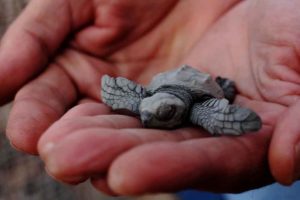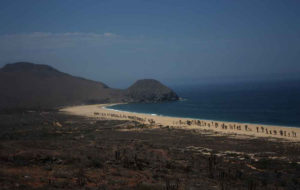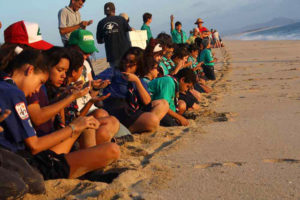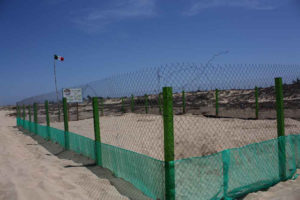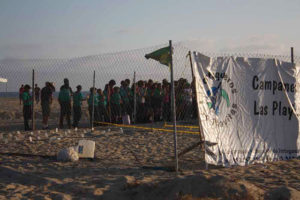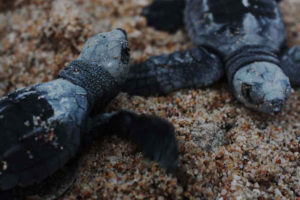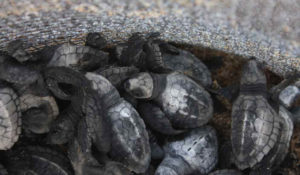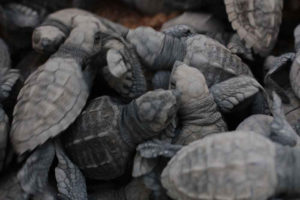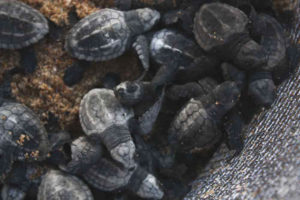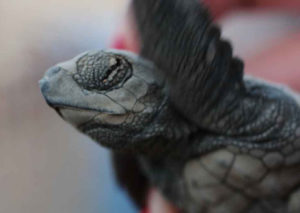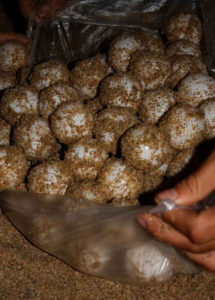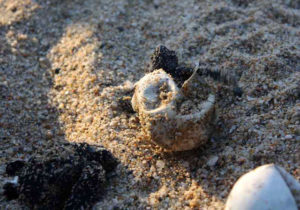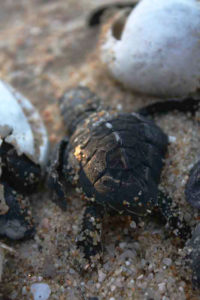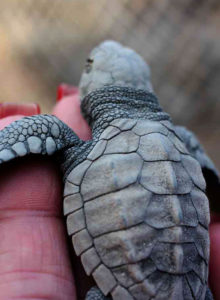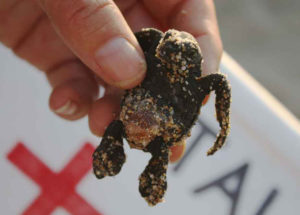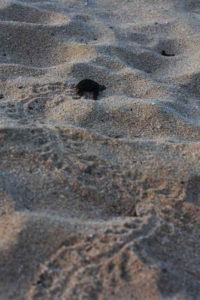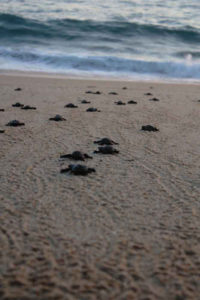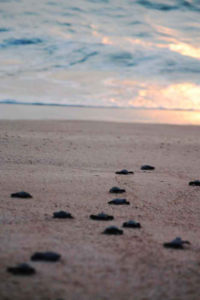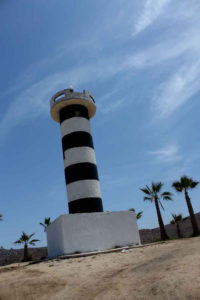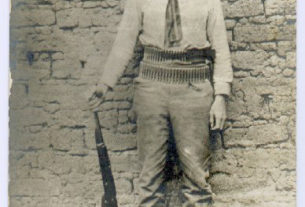The sun is setting off the coast of Todos Santos, Baja California Sur and, even though we are in the tropics, we are bundled up in heavy, hooded sweatshirts and jeans to protect us from the damp, chilly evening air.
Rough waves from the Pacific Ocean crash against the beach on this side of the peninsula. A whale spouts offshore against the darkening horizon as it heads around the cape and into the Sea of Cortes on its annual migration run.
A handful of volunteers carry Styrofoam coolers to within 20 yards of the surf line and unload their wares.
The beach suddenly springs to life as hundreds of palm-sized Olive Ridley turtles make their way to the water for the first time.
Another batch of endangered sea creatures is making its way to the sea, safe from predators like raccoons, coyotes, and men who would collect the eggs or flesh to sell on the black market. The eggs, according to local folklore, are considered an aphrodisiac, the meat, a delicacy. Adult turtles are also victimized by commercial fishermen who use long-line and gill nets that entangle and kill the animals.
“In nature,” says Francesca Dvorak, who is leading the turtle hatchling release efforts in Todos Santos, “less than 50 percent of the eggs would hatch.” Through the efforts of her team of volunteers, the hatch rate jumps to about 80 percent.
“We relocate the eggs into a protected corral and supervise hatching so the crabs and birds cannot get to them,” she said. “We are also eliminating the threats on land and making sure they get into the ocean.”
Dvorak and her husband, German Aguendez, own LaSirena Eco-Adventures, a Baja company that specializes in environmentally friendly tourist activities like whale watching, fishing, kayaking, hiking, and other outdoor activities. They also own the local federal permit to participate in La Baja’s growing endeavor to rescue the eggs and release the hatchlings of Olive Ridley, Black, and the massive Pacific Leatherback sea turtles along a 36-kilometer stretch of beach in Todos Santos.
“A friend of ours invited us to go out on patrol one night to look for nests,” Dvorak explained. “I enjoyed it so much I thought we could help the group.”
Dvorak had been an educator in San Diego, where she taught second and fourth grades. Environmental responsibility became a part of her curriculum. Her students learned about recycling, participated in beach cleanups, and whale watching.
Eleven years ago, she permanently relocated to the tip of Baja California Sur.
Todos Santos is a quaint little town that, like most of the surrounding communities, lived off the sea. The commercial fishing was so prolific at one point that a cannery was built offshore from Cabo San Lucas, 48 miles to the southwest, to handle the processing.
Fishermen would take their small boats out daily, rough seas or calm, and chase the large tuna that once choked the waters to the west of La Baja.
The beach at Todos Santos is clean. The white sand seems to stretch endlessly in both directions and the waves crash mightily onto the shore.
On one end of the beach stands an old, abandoned lighthouse where a very small fleet of boats still sets sail daily to fish the deep blue waters of the Pacific Ocean, just as their fathers and grandfathers did for centuries before. Nearby there is a small shrine dedicated to the fishermen who took to the sea from that very spot to feed their families, their communities, in boats powered only by the sail or oar.
There are still a lot of tuna in those waters, but nothing like before, the old-timers will tell you.
So, now the local economy relies on an expanding tourist base.
There are three paved roads in all of Todos Santos — one along the main drag where Mexico Highway 1 runs through town past the police station, Miguel’s restaurant, and some shops and fuel stations. Another curves around in front of the Hotel California, which opened in 1950, long before the Eagles wrote their hit song about the California state of mind. It is surrounded by gift shops and art galleries. The third paved road takes you to a large municipal park, more shops, more restaurants.
The rest of the town sits along dusty, dirt roads. The closer you get to the beach, the more overgrowth there is, with towering palms and trees heavy with mangoes. An ATV is a must to negotiate the steep, winding roads which, in some places, are little more than a trail.
Very expensive, modern haciendas line up next to smaller, more traditional homes and the neighborhood dogs all know the shadiest spots to shelter themselves from the midday sun.
There is a freshwater lake just beyond the beachhead, where pelicans dive for the hybrid sunfish that thrive in the tropical water.
Like in most of La Baja, cattle roam the area freely, grazing on the succulent grasses offered in this little oasis. It’s populated by a variety of mammals that range from the strikingly odd-looking coatimundi to its cousin the raccoon, plus an assortment of bright and graceful birds that ride the thermals as they circle overhead for food.
Nature strives for a balance here, but without the hand of enlightened man, it would struggle.
Efforts to propagate the Olive Ridleys, Black, Pacific Leatherback, and other turtle species play a large role in maintaining that balance.
“It’s important to know that the survival of the Pacific Leatherback is a worldwide problem,” Dvorak said. “When we start losing top predators, the ocean gets imbalanced. Lose the Leatherback and you get too many jellyfish. Jellyfish eat fish eggs. When you have too many jellyfish you get huge declines in fish populations.
“The same with sharks. They’re killing sharks by the thousands for their fins for shark fin soup. Eliminate a top predator like the shark and you get too many sea lions and seals, and what do they eat? Fish. Eliminate sharks and sea turtles and the fish population goes down.”
Gwen D. Goodmanlowe is an undergraduate advisor in marine biology at California State University, Long Beach.
She agrees with Dvorak.
“Any time you remove a large predator from an ecosystem you are changing the entire ecology of that ecosystem because of top-down effects where the predator causes effects on its prey that cascade down the food chain,” Goodmanlowe said. “Similarly, if you remove organisms from the bottom of the food chain you get bottom-up effects.”
She pointed out that it’s not only the Olive Ridleys, Black, and Pacific Leatherbacks that have a hand in controlling the environment.
“Not all turtles eat sea jellies,” she said. “Green sea turtles eat turtle grass, so they are very important in the ecology of those habitats. In the case of green sea turtles, they maintain the health of the sea grass beds by grazing and keeping them short, which keeps the sea grass healthy so that other organisms can feed on it and use it as habitat. Sea grass beds are important breeding and nursery grounds for a wide variety of invertebrates and fish, so you change the whole ecology of that habitat if you remove the turtles.
“Each turtle eats different things so each ecosystem is changed if you remove turtles from the equation. Hawksbills feed on inverts and sponges on coral reefs; loggerheads feed on crabs, mollusks and sea jellies, etc.”
Enedino Castillo is a marine biologist and the director of Grupo Tortuguero de Todos Santos, an organization that also participates in the preservation of sea turtles.
His soft brown eyes reflect the gentleness of his soul as he describes how he witnessed the slaughter of these turtles for food and profit.
He teaches science at the local middle school, he says through a translator, where he tries to educate the children about environmental issues.
He says it is the best way to get the message through to their parents that it is wrong to harvest the turtle eggs and flesh. Castillo says that it is important to bring up the next generation to have a respect for the fragile environment, to protect it, to assist where it can to preserve its delicate balance.
It’s a method Dvorak uses as well.
“We do presentations in the elementary schools on conservation and sea turtle biology,” she said. “We go to the schools and tell them, ‘Okay, this week we have lots of turtles. Come out and help us release them.'”
She said this season, she has had about 1,000 students from La Paz to Cabo San Lucas come out to help with turtle releases.
“The turtle project also does all kinds of mini-programs. We have a recycling campaign, we’re doing environmental education through a program called Junior Lifeguards and another called Junior Marine Biologists. We want the children to grow to love nature and the environment (because then they are) more likely to protect it as adults.”
The turtle rescue groups rely heavily on volunteers. In the more populated cities of Cabo San Lucas and San Jose del Cabo, even the local hotels and resorts get involved, sending teams of scientists and volunteers to their beachfront when the turtles come ashore to collect and preserve the eggs, then release the young.
Most of these are hand-to-mouth operations, with little money coming in and more work than there are volunteers.
And, although Mexico is making rapid strides in conservation and protecting the environment, there is little in the way of financial support.
In fact, when Dvorak first became involved with rescuing turtles, one of the first things she did was make a trip to San Diego to purchase an ATV, which was necessary for late-night beach patrols to discover new nests.
“This year, besides the students, we’ve had seven volunteers,” she said. “That’s a few more than last year. But, to volunteer for this costs money. You have to fly here, get accommodations, pay for food. We don’t have a big beach house or camp where they can come and camp on the beach. Besides, with the way the economy has been, travel has been affected so there is less tourism, less volunteerism on the whole.
“The Mexican government acknowledges the risk to the sea turtle. There’s definitely more awareness because the status is known worldwide. They acknowledge it, but don’t necessarily help that much. I mean we don’t get a new ATV or greenhouse from the government.”
Goodmanlowe said she is happy to see more interest from the Mexican government, but adds there is still a lot of work to be done in Mexico and elsewhere.
“As far as Mexico is concerned, I think it is great that they are coming around to conservation efforts for a wide variety of marine organisms,” she said. “They have a long way to go (with sharks, the Vaquita, and a lot of other organisms). I think education is the key and the more we can educate people and figure out a way to protect organisms without people losing their livelihoods, the better.
“It is very difficult, though. There is still a lot of opposition in the U.S. to TEDs (turtle excluding devices wildlife organizations urge commercial fishermen to use) because they are more expensive than regular shrimp nets (and other commercial fishing equipment).”
As our evening turned to nighttime, the turtle hatchlings crossed the span from shore to water, the little black dots on the sand disappearing, group by group, into the ocean.
And, just before the sun dipped into the Pacific, you could see them, waving their flippers madly in the surf as they headed out to sea.
Baja Turtle Facts
Nesting season
- Olive Ridleys — July through November
- Black Turtles (a smaller, darker version of the Green Turtle) — August through January
- Pacific Leatherbacks — October through April.
Hatchlings are released about 45 days after the eggs are collected. It takes sea turtles approximately seven years to mature and reproduce. At that time, the female returns to her natal beach to lay her eggs. A mature female can lay as many as 100 eggs at a time and could have two sets of eggs per season.
Protection
All species of sea turtles are listed as either endangered or threatened. The Pacific Leatherback is listed as critically endangered.
Rescue practices
Teams of volunteers patrol the beaches late at night, looking for drag trails of female turtles that have come ashore to lay their eggs. The teams follow those trails to the turtle nesting spots, collect the eggs, and bring them to a sheltered pen where they dig holes about two feet deep and store the eggs. The new nests are marked and documented. Forty-five days later, volunteers return to the pens and collect the hatchlings from their temporary nests. They are taken to the shore, where they are released.
What Is Needed
- GPS to mark nests
- Maintenance of existing ATVs; purchase of new vehicles
- Ongoing maintenance of the greenhouse that serves as an incubator for the turtles
- Field tools, such as flashlights, batteries, temperature sensors, warm clothing, cameras, cell phones, and cell phone cards
- Two pairs of infrared binoculars to help find nesting turtles after dark
To Donate
La Sirena – Sea Turtle Eco Tours in Todos Santos
www.lasirenakayaksurf.com
Todos Tortugueros, A.C.
www.todostortugueros.org

